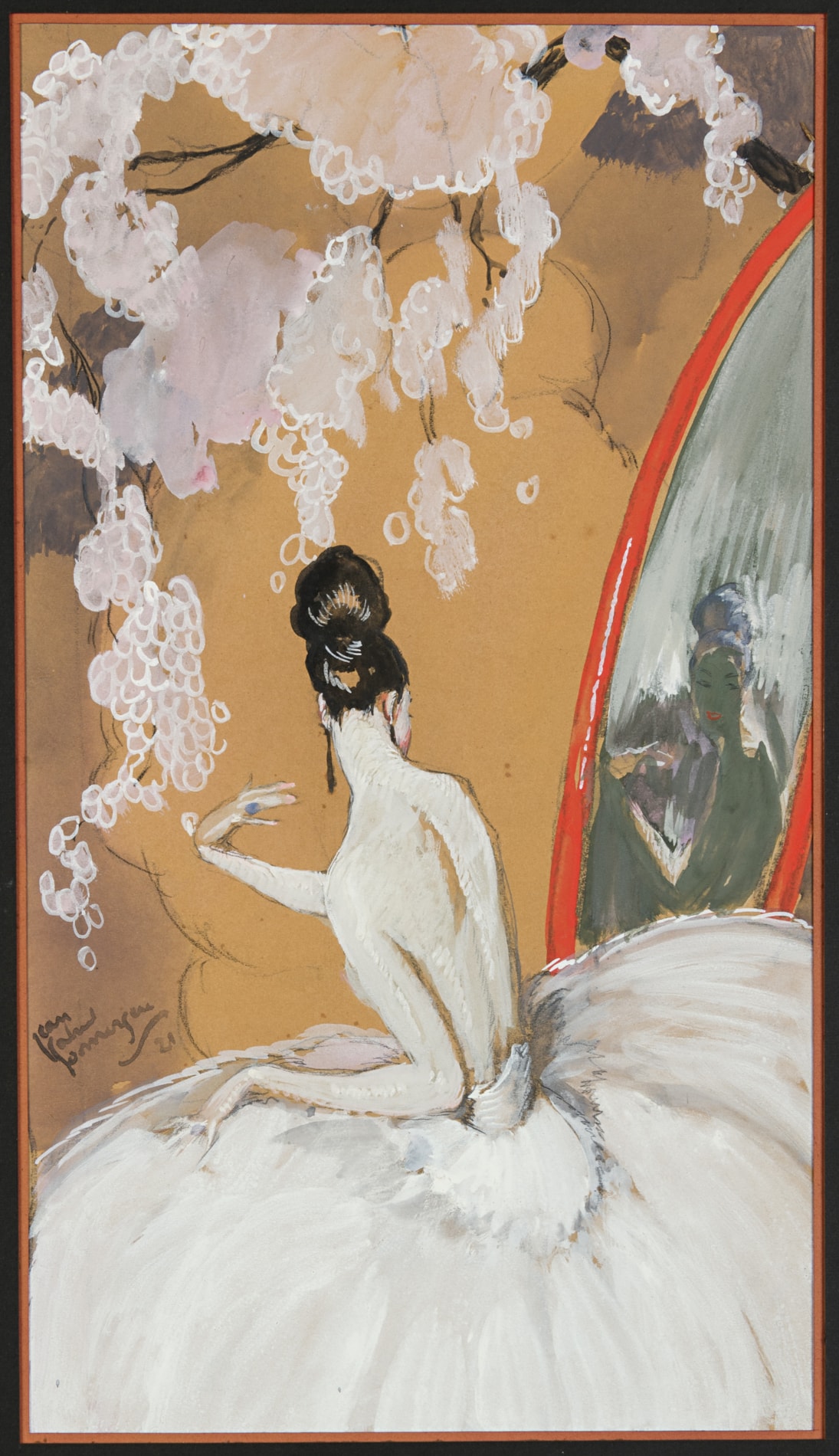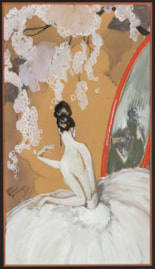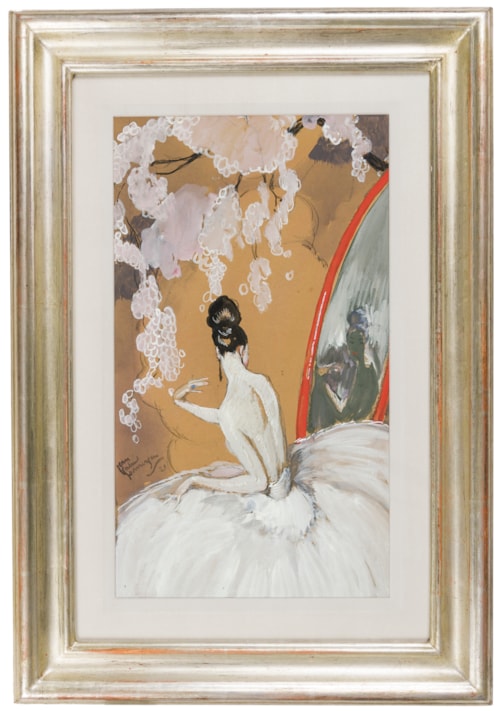Jean-Gabriel DOMERGUE
(Bordeaux 1889 - Paris 1962)
An Elegant Woman at a Mirror, under a Spray of Wisteria
Gouache and charcoal on buff paper, laid down on board.
Signed and dated jean / gabriel / domergue / 21 at the centre left. Signed and inscribed jean / gabriel / domergue / Le princesse(?) aux(?) fleurs on the backing board.
Further partially inscribed Domergue / [fem]me vue de dos assise on a torn label pasted onto the backing board.
410 x 231 mm. (16 1/8 x 9 1/9 in.) [sight]
Signed and dated jean / gabriel / domergue / 21 at the centre left. Signed and inscribed jean / gabriel / domergue / Le princesse(?) aux(?) fleurs on the backing board.
Further partially inscribed Domergue / [fem]me vue de dos assise on a torn label pasted onto the backing board.
410 x 231 mm. (16 1/8 x 9 1/9 in.) [sight]
This gouache drawing may be related to a handful of similar compositions of a young woman seated in front of a tall mirror that Jean-Gabriel Domergue produced in the early 1920s. It is particularly close to the left half of a painting of Eve at a Mirror of 1921, which depicts a woman looking into a mirror held by a lascivious satyr, with a golden carriage behind. A variant of the composition, with the addition of a standing nude woman, is found in a gouache drawing, likewise dated 1921, which was sold at auction in 2012, while the artist also used a similar composition in a number of large folding screens. A painting of an analogous subject, entitled Dans l’ombre d’une jeune fille en fleur, dated 1922 and exhibited at the Salon of that year, depicts a woman with a fan, dressed in white, underneath a spray of wisteria.
Jean-Gabriel Domergue displayed an artistic talent from an early age, winning a drawing competition in Paris and receiving a portrait commission at the age of fourteen. A student at the Ecole des Beaux-Arts in Paris between 1903 and 1910, he first exhibited at the Salon des Artistes Français in 1906, at the age of seventeen, gaining an honourable mention. Domergue won the Second Prix de Rome in 1913, and in 1920 earned a gold medal at the Salon des Artistes Français. The same year he was among the founders of the Salon de la Mode par les Artistes, devoted to fashion in painting, drawing, sculpture and decoration, which continued for the next decade. His work was much in demand, for advertising posters, book covers and illustrations, costume designs and stage sets, fashion illustrations, and, in particular, as a painter of the elegant Parisian woman. As has been noted of the artist, ‘With a skilful and witty brush, he had the art of translating the light, piquant, sparkling side of the pretty woman as one readily imagines her. Like Watteau and Fragonard in the 18th century, he is the great arbiter of feminine evolution, launching fashions, helping to create the type of beauty of his time.’ Although he often used young dancers or actresses as models, he also painted a number of society portraits, and over the course of his career is thought to have produced some three thousand paintings.
Domergue also worked occasionally as a decorative painter on a larger scale, painting murals for the theatre in the city of Agen in 1911 and at the Château d’Osmond in the Haut-Médoc in 1921. Domergue organized fashionable balls and galas in Paris, such as the 1922 Venetian Ball at the Opéra, as well as events in Deauville, Juan-les-Pins, Monaco, Biarritz and Cannes, where in 1926 he built a villa that later became a museum devoted to his work. Apart from the Salon des Artistes Français and the Salon d’Automne, he also exhibited at the Royal Academy in London and at the Carnegie International in Pittsburgh. In 1933 Domergue was admitted into the Légion d’Honneur, and in 1950 he was appointed to the Institut of the Académie des Beaux-Arts. From 1955 until his death he served as a curator at the Musée Jacquemart-André in Paris, where he organized a series of important monographic exhibitions on such artists as Toulouse-Lautrec, Seurat, Van Gogh, Goya and others. Domergue was in the midst of preparing an exhibition devoted to one of his greatest influences as an artist, the society painter Giovanni Boldini, when he died in November 1962, at the age of seventy-three.
Domergue also worked occasionally as a decorative painter on a larger scale, painting murals for the theatre in the city of Agen in 1911 and at the Château d’Osmond in the Haut-Médoc in 1921. Domergue organized fashionable balls and galas in Paris, such as the 1922 Venetian Ball at the Opéra, as well as events in Deauville, Juan-les-Pins, Monaco, Biarritz and Cannes, where in 1926 he built a villa that later became a museum devoted to his work. Apart from the Salon des Artistes Français and the Salon d’Automne, he also exhibited at the Royal Academy in London and at the Carnegie International in Pittsburgh. In 1933 Domergue was admitted into the Légion d’Honneur, and in 1950 he was appointed to the Institut of the Académie des Beaux-Arts. From 1955 until his death he served as a curator at the Musée Jacquemart-André in Paris, where he organized a series of important monographic exhibitions on such artists as Toulouse-Lautrec, Seurat, Van Gogh, Goya and others. Domergue was in the midst of preparing an exhibition devoted to one of his greatest influences as an artist, the society painter Giovanni Boldini, when he died in November 1962, at the age of seventy-three.





